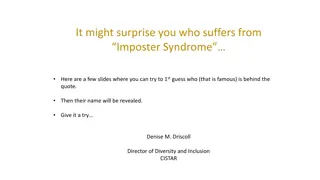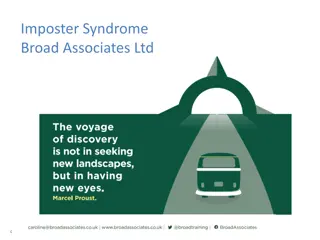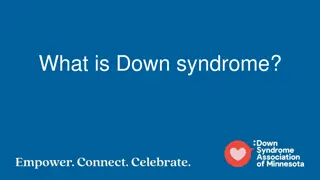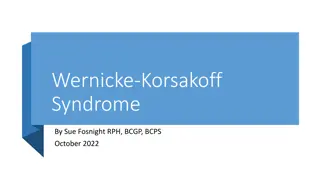Pusher Syndrome
Pusher Syndrome, also known as contraversive pushing, is characterized by leaning and active pushing towards the hemiplegic side in patients with right hemispheric lesions resulting in left hemiplegia. Common characteristics include spatial neglect, postural asymmetries, and fear of falling towards the non-paretic side. Distinguishing Pusher Syndrome from other disorders like Thalamic Astasia and Wallenberg's Syndrome is crucial for accurate diagnosis and management.
Download Presentation

Please find below an Image/Link to download the presentation.
The content on the website is provided AS IS for your information and personal use only. It may not be sold, licensed, or shared on other websites without obtaining consent from the author.If you encounter any issues during the download, it is possible that the publisher has removed the file from their server.
You are allowed to download the files provided on this website for personal or commercial use, subject to the condition that they are used lawfully. All files are the property of their respective owners.
The content on the website is provided AS IS for your information and personal use only. It may not be sold, licensed, or shared on other websites without obtaining consent from the author.
E N D
Presentation Transcript
Pusher Syndrome Cassie Short, SPT UNC-DPT Class of 2013
What is it? O Characterized by leaning and active pushing toward the hemiplegic side in all positions using the non-paretic arm and leg, and resistance to any attempt at passive correction of posture towards midline or across the body towards the non-affected side. O Patients have subjectively reported their impression of lateral instability and the fear of falling toward the non-paretic side. O AKA- ipsilateral pushing , contraversive pushing , pusher behavior
Common Characteristics O Primarily right hemispheric lesions, resulting in left hemiplegia O Spatial and sensory neglect of hemiplegic side O Postural asymmetries, causing a characteristic shift of body weight toward the hemiplegic side, with no attempt to compensate for the imbalance O Patients complain of falling towards the non- paretic side
Distinguishing PS O Active pushing with the non-paretic extremities helps to distinguish patients with PS from other related disorders such as: O Thalamic astasia O Wallenberg s syndrome O Vestibular cortex lesions
Thalamic Astasia O The inability to stand unsupported, resulting from a lesion of the posterolateral thalamus O Cannot sit independently, have obvious truncal instability, fall backward or to the affected side from a sitting position when unsupported. O Use unaffected side to pull themselves upright when asked to sit up O PS patients extend the unaffected arm and use it to actively push away from the non-paretic side when asked to sit up O Also, TA characteristically has very mild or no motor weakness unlike PS who have severe hemiparesis of the contralateral arm and leg
Wallenbergs Syndrome O Acute unilateral brainstem infarctions in the area of the medulla O Display a tilt of the subjective visual vertical (visual perception of the upright position), lateropulsion (a tendency to fall sideways) without active pushing or resistance to passive correction, and a deviation of the COG toward the ipsilesional, non-paretic side O Fall sideways towards the side of the lesion or ipsilateral side, and PS patients fall to the opposite side of the lesion or contralateral side
Vestibular Cortex O Cerebral lesions in posterior insula- or the vestibular cortex O Commonly experience a perceived tilt of the subjective VISUAL vertical O Do not typically produce impairments of postural control such as falling to one side, indicating that their perception and performance of the subjective postural vertical is intact O Patients with PS display an impaired perception of subjective POSTURAL vertical, demonstrating a severe tilt of the pelvis with active pushing towards the hemiplegic side and falling toward that side. They are able to keep a correct head orientation toward vertical even in the presence of a severe lateral lean.*
Statistics O Displayed in 5% of all patients post-stroke, 10% of patients referred for neurologic rehabilitation. O These are the most severely impaired patients with profound functional limitations in transfers, standing, and gait. O Individuals with pusher syndrome take 63%longer than average time to recover independence post-stroke. O 80% of patients with right brain lesions and pushing displayed spatial neglect and somatosensory impairment.
Location & Cause O Study conducted by Karnath et al- looked at the MRI scans of 23 patients with severe pusher syndrome O Overlapping area of these infarctions centered on that of the posterolateral thalamus (anatomically distinct from the vestibular cortex in the posterior insula, but similar to the area of patients with thalamic astasia), extensions including the ventral posterior nucleus, lateral posterior nucleus and its cortical projections. O All seem to be involved in the neural representation of the graviceptive system which is critical for our control of upright body posture.
O This area extends from the posterolateral thalamus into the posterior crus of the internal capsule, which explains the severe hemiparesis (which was present in all 23 patients in this study) O Perennou et al.- performed a kinematic analysis which showed that pusher syndrome is not the result of disrupted processing of vestibular information, but rather a disturbed neural representation of the truncal graviceptive system- Suspected as a graviceptive neglect - defined as extinction of graviceptive signals originating in the contralesional part of the trunk and pelvis. O Karnath et al.- conducted a study where they concluded patients perceived their bodies oriented as upright when tilted ~18 deg to their ipsilesional side
Functional Assessment O The Standardized Scale for Contraversive Pushing (SCP)- Karnath et al. O Measures the degree of pushing behavior that is present in patients post-stroke O Assesses: O Posture: symmetry of spontaneous posture while sitting and standing O Extension: the use of the ipsilesional arm or leg to extend the area of physical contact to the ground while sitting and standing O Resistance: resistance to passive correction of posture while sitting and standing
SCP O You give 1-point for sitting ability and 1-point for standing ability, in each of the 3 sections for a maximum of 2-points for each section; and 6-points total. O Patients are scored as possessing pusher syndrome if all 3 criteria are present, reaching a total score of at least 1 for each criterion. O *GUIDELINE- hasn t been thoroughly investigated for its reliability and validity
PT Interventions & Strategies O AIM: To regain the awareness of midline O KEY: Use of visual cues along with cognitive strategies O Restorative Strategies 11 O Use visual feedback by placing a mirror in front of them and instruct patient to self-correct themselves back to midline O In all postural sets, ask the patient to identify the position of their body and describe their relationship to supporting surface O Get the patient to move between postural sets and for them to maintain their balance
PT Interventions & Strategies O Adaptive Strategies 11 O Place pillows on the overactive side to provide extra supporting surfaces to enhance the patient s feeling of security O When seated in a wheelchair, place the hospital bed in a high position on the overactive side to enhance feelings of security O Teach the patient to use vertical structures within the room such as a door or window frames to adjust balance with reference to these markers
Physical Therapy Interventions O 30 min session- Standing with feet placed apart, first with back supported against a wall, progressing to no support, then incorporating movement O Learn to balance after introducing patient to the appropriate position over their feet, providing practice and feedback, can achieve short duration of independent static standing (Bohannon) O Align the body axis to earth-vertical with help of visual cues in a controlled environment- *used in conjunction with postural strategies O Body immobilized by lateral stabilization, legs hanging freely, patients instructed to concentrate on visual information available in environment (Karnath et al.)
Bohannon RW. Ipsilateral pushing in stroke. Arch Phys Med Rehabil. 1996;77:524- 525. Brandt T, Dieterich M, Danek A. Vestibular cortex lesions affect the perception of verticality. Ann Neurol. 1994; 35:403-412. Davies PM. Steps to Follow: A Guide to Treatment of Adult Hemiplegia. New York, NY: Springer-Verlag; 1985. Karnath HO, Johannsen L, Broetz D, et al. Prognosis of contraversive pushing. J Neurol. 2002;249:1250-1253. Karnath HO, Ferber S, Dichgans J. The neural representation of postural control in humans. Proceedings of the National Academy of Sciences of the United States of America. 2000;97:13931-13936. Karnath HO, Ferber S, Dichgans J. The origin of contra-versive pushing:evidence for a second graviceptive system in humans. Neurology. 2000;55:1298-1304. Karnath HO, Brotz D, Gotz A. [Clinical symptoms, origin, and therapy of the pusher syndrome]. Nervenarzt. 2001;72:86-92. Masdeu JC, Gorelick PB. Thalamic astasia: inability to stand after unilateral thalamic lesions. Ann Neurol. 1988;23:596-603. Pedersen PM, Wandel A, Jorgensen HS, et al. Ipsilateral pushing in stroke: incidence, relation to neuropsycho-logical symptoms, and impact on rehabilitation. The Copenhagen Stroke Study. Arch Phys Med Rehabil. 1996;77:25-28. Perennou DA, Amblard B, Laassel el M, et al. Understanding the pusher behavior of some stroke patients with spatial deficits: a pilot study. Arch Phys Med Rehabil. 2002;83:570-575. Reid, L. and Edmans, J. (2010) Management of Perceptual Impairments, in Occupational Therapy and Stroke, Second Edition (ed J. Edmans), Wiley-Blackwell, Oxford, UK. doi: 10.1002/9781444323801.ch8 Roller, Margaret L. Journal of Neurologic Physical Therapy. 2004; 28(1):29. 1. 2. 3. 4. 5. 6. 7. 8. 9. 10. 11. 12.
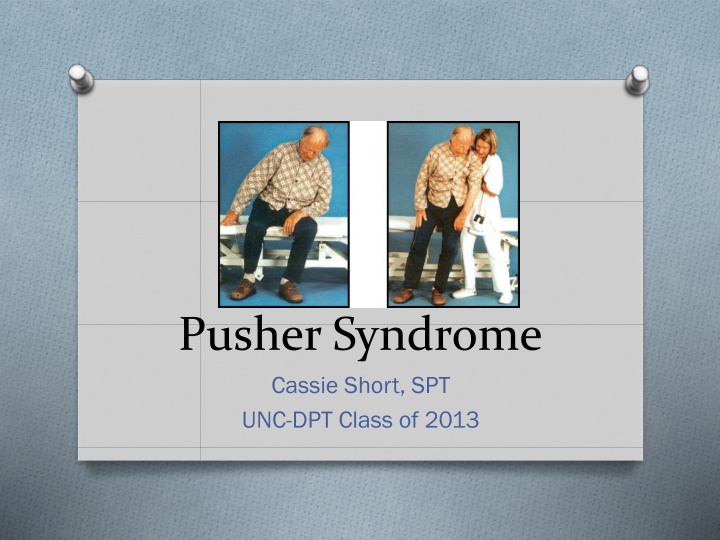

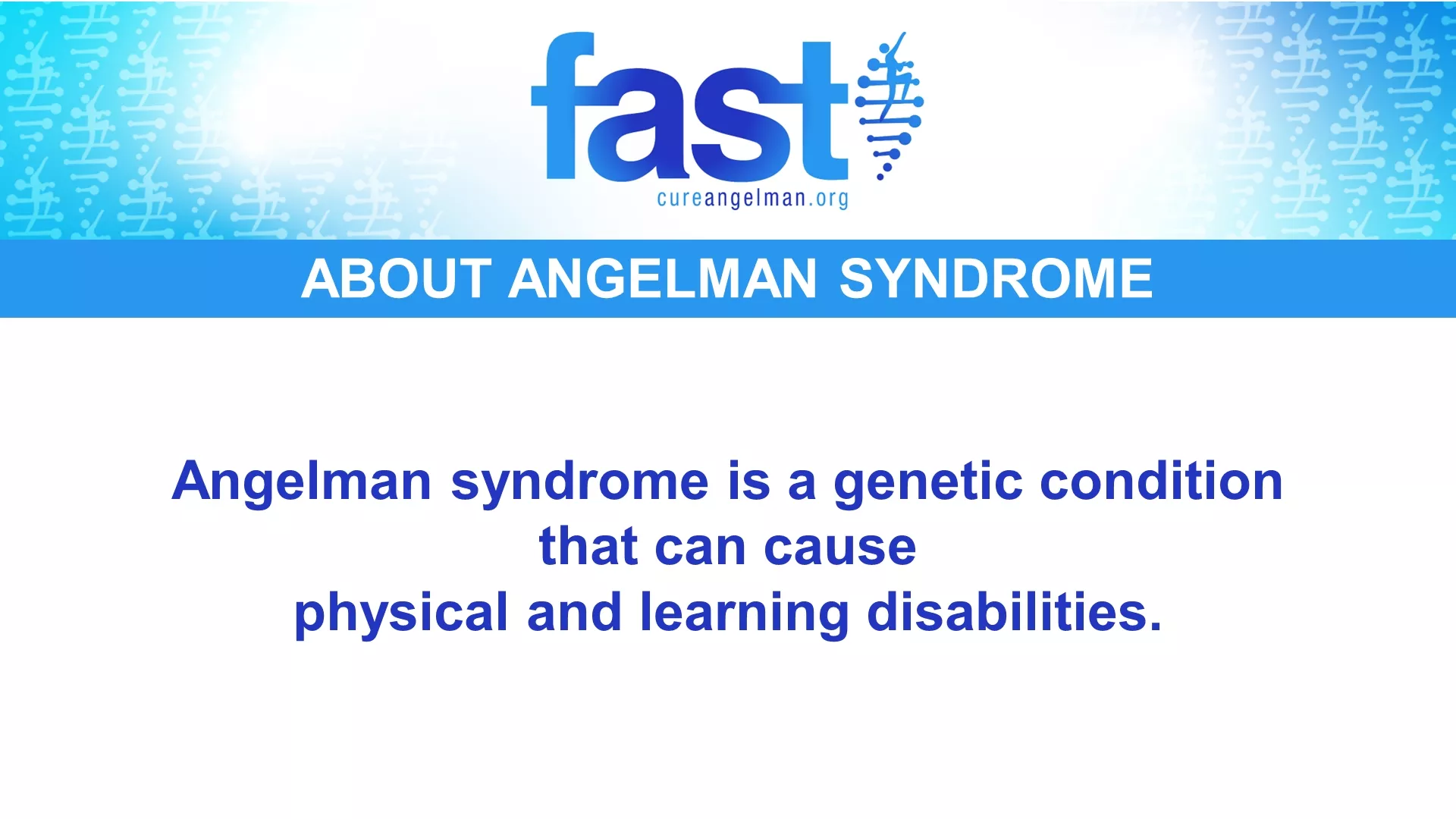
![❤[PDF]⚡ Zee Zee Does It Anyway!: A Story about down Syndrome and Determination](/thumb/20462/pdf-zee-zee-does-it-anyway-a-story-about-down-syndrome-and-determination.jpg)


